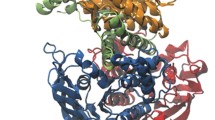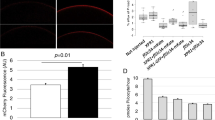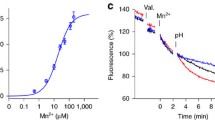Summary
The effect of mutation of either Lys 558 or Lys 869 or both on mouse erythroid band 3 protein (AE1)-mediated 36Cl− efflux and its inhibition by pyridoxal 5-phosphate (P5-P), DNDS and H2DIDS were studied. Regardless of the mutation, band 3 was always capable of executing Cl− self-exchange. P5-P (5 mm, pH 7.6) produced irreversible inhibition in the wild type (KK) and in the mutant in which Lys 558 (NK) or Lys 869 (KM) had been replaced by asparagine (N) or methionine (M), respectively. However, when both residues were replaced, mutant (NM), irreversible inhibition could no longer be achieved. This shows that P5-P is capable of producing inhibition with either one of the lysine residues, 558 or 869.
Inhibition by DNDS changed dramatically upon mutation. The K iapp increased from 6.0 μ m in the wild type (KK) to 23 μ m in the mutant NK, to 73 μ m in the mutant KM and to 474 μ m in the double mutant NM. The K m value for activation of the transport system by varying the substrate concentration by isosmotic substitution of Cl− with SO 2−4 decreased from 42 mm in the wild type (KK) to 11.3 mm in the mutant NM. The results show that both Lys 558 and Lys 869 are involved in the maintenance of the structure of the overlapping binding sites for stilbene disulfonates and the substrate Cl−.
In the double mutant NM, H2DIDS is no longer able to produce irreversible inhibition at pH 7.6. This is evidently related to the replacement of Lys 558 (pK 8.2) by Asn 558 in this mutant (see Bartel, D., Lepke, S., Layh-Schmitt, G., Legrum, B., Passow, H., 1989. EMBOJ. 8:3601-3609). However, at pH 9.5, some irreversible inhibition could still be observed. This suggests that the other lysine residue (pK 10.8) that is known to be involved in covalent binding with the second isothiocyanate group of H2DIDS is still present, and hence, not identical to Lys 869, which had been substituted by a methionine residue. However, this result remains inconclusive since after mutagenesis, the H2DIDS may produce inhibition at a site that is not normally involved in H2DIDS binding.
Similar content being viewed by others
Abbreviations
- DNDS:
-
4,4′-dinitro stilbene-2,2′-disulfonate
- DAS:
-
4,4′-diacetamido stilbene-2,2′-disulfonate
- DBDS:
-
4,4′-dibenzoyl stilbene-2,2′-disulfonate
- SITS:
-
4,-acetamido, 4′-isothiocyano stilbene-2,2′-disulfonate
- H2DIDS:
-
4,4′-diisothiocyano dihydro stilbene-2,2′-disulfonate
- DIDS:
-
4,4′-diisothiocyano stilbene-2,2′-disulfonate
- P5-P:
-
pyridoxal 5-phosphate
References
Bar-Noy, S., Cabantchik, Z.I. 1990. Transport domain of the erythrocyte anion exchange protein. J. Membrane Biol. 115:217–228
Bartel, D., Hans, H., Passow, H. 1989a. Identification of Lys 558 as the covalent attachment site of H2DIDS to the mouse erythroid band 3 protein by site-directed mutagenesis. Biochim. Biophys. Acta 985:355–358
Bartel, D., Lepke, S., Layh-Schmitt, G., Legrum, B., Passow, H. 1989b. Anion transport in oocytes of Xenopus laevis induced by expression of mouse erythroid band 3 protein-encoding cRNA and of a cRNA derivative obtained by site-directed mutagenesis at the stilbene disulfonate binding site. EMBO J. 8:3601–3609
Barzilay, M., Cabantchik, Z.I. 1979. Anion transport in red blood cells. II. Kinetics of reversible inhibition by nitroaromatic sulfonic acids. Membr. Biochem. 2:255–281
Cabantchik, Z.I., Balshin, M., Breuer. W., Rothstein, A., 1975. Pyridoxal phosphate. An anionic probe for protein amino groups exposed on the outer and inner surfaces of intact human red blood cells. J. Biol. Chem. 250:5130–5136
Cabantchik, Z.I., Rothstein, A. 1974. Membrane proteins related to anion permeability of human red blood cells. I. Localization of disulfonic stilbene binding sites in proteins involved in permeation. J. Membrane Biol. 15:207–226
Cobb, Ch.E., Beth, A.H. 1990. Identification of the eosinyl-5-maleimide reaction site on the human erythrocyte anion exchange protein: Overlap with the reaction sites of other chemical probes. Biochemistiy 29:8283–8290
Cousin, J.L., Motais, R. 1979. Inhibition of anion permeability of amphiphilic compounds in human red cell: Evidence for an interaction of niflumic acid with the band 3 protein. J. Membrane Biol. 46:125–153
Cousin, J.L., Motais, R. 1982a. Inhibition of anion transport in the red blood cell by anionic amphiphilic compounds. I. Determination of the flufenamate-binding site by proteolytic dissection of the band 3 protein. Biochim. Biophys. Acta 687:147–155
Cousin, J.L., Motais, R. 1982b. Inhibition of anion transport in the red blood cell by anionic amphiphilic compounds. II. Chemical properties of the flufenamate-binding site on the band 3 protein. Biochim. Biophys. Acta 687:156–164
Falke, J.F., Pace, R.J., Chang, S.I. 1984. Chloride binding to the anion transport binding site of band 3. A 35Cl NMR study. J. Biol. Chem. 259:6472–6480
Fröhlich, O. 1982. The external anion binding site of the human erythrocyte anion transporter: DNDS binding and competition with chloride. J. Membrane Biol. 65:111–123
Fröhlich, O., Gunn, R.B. 1982. Mutual interactions of reversible inhibitors on the red cell anion transporter. Biophys. J. 37:213a
Glibowicka, M., Winckler, B., Aranibar, N., Schuster, M., Hanssum, H., Rüterjans, H., Passow, H. 1988. Temperature dependence of anion transport in the human red blood cell. Biochim. Biophys. Acta 946:345–358
Grygorczyk, R., Hanke-Baier, P., Schwarz, W., Passow, H. 1989. Measurement of erythroid band 3 protein-mediated anion transport in mRNA-injected oocytes of Xenopus laevis. Methods Enzymol. 173:453–466
Jennings, M.L. 1989. Structure and function of the red blood cell anion transport protein. Annu. Rev. Biophys. Biophys. Chem. 18:397–430
Jennings, M.J., Passow, H. 1979. Anion transport across the erythrocyte membrane, in situ proteolysis of band 3 protein, and cross-linking of proteolytic fragments by 4,4′-diisothiocyano dihydrostilbene-2,2′-disulfonate. Biochim. Biophys. Acta 554:498–519
Kampmann, L., Lepke, S., Fasold, H., Fritzsch, G., Passow, H. 1982. The kinetics of intramolecular cross-linking of the band 3 protein in the red blood cell membrane by 4,4′-diisothiocyano dihydrostilbene-2,2′-disulfonic acid (H2DIDS). J. Membrane Biol. 70:199–216
Kawano, Y., Hamasaki, N. 1986. Isolation of a 5,300-dalton peptide containing a pyridoxal phosphate binding site from the 38,000-dalton domain of band 3 of human erythrocyte membranes. J. Biochem. (Tokyo) 100:191–199
Kawano, Y., Okubo, K., Tokunaga, F., Miyata, T., Iwanaga, N., Hamasaki, N. 1988. Localization of the pyridoxal phosphate binding site at the COOH-terminal region of erythrocyte band 3 protein. J. Biol. Chem. 263:8232–8238
Kietz, D., Bartel, D., Lepke, S., Passow, H. 1991. pH-dependence of inhibition by H2DIDS of mouse erythroid band 3-mediated Cl− transport in Xenopus oocytes. The effect of oligonucleotide-directed replacement of Lys 558 by an Asn residue. Biochim. Biophys. Acta 1064:81–88
Knauf, P.A. 1979. Erythrocyte anion exchange and the band 3 protein: Transport kinetics and molecular structure. Curr. Top. Membr. Transp. 12:249–363
Kramer, W., Fritz, H.J. 1987. Oligonucleotide-directed construction of mutations via gapped duplex DNA. Methods Enzymol. 154:351–367
Lepke, S., Passow, H. 1976. Effects of incorporated trypsin on anion exchange and membrane proteins in human red blood cell ghosts. Biochim. Biophys. Acta 455:353–370
Passow, H. 1986. Molecular aspects of band 3 protein-mediated anion transport across the red blood cell membrane. Rev. Physiol. Biochem. Pharmacol. 103:62–223
Passow, H., Bartel, D., Lepke, S., Layh-Schmitt, G., Raida, M., Wendel, J., Legrum, B., Furuto-Kato, S. 1989. Studies on band 3 protein-mediated anion transport in mouse red blood cells and in oocytes of Xenopus laevis after expression of mouse band 3-encoding cRNA. In: Anion Transport Protein of the Red Blood Cell Membrane. N. Hamasaki and M.L. Jennings, editors, pp. 133–149. Elsevier, Amsterdam
Passow, H., Fasold, H., Gärtner, E.M., Legrum, B., Ruffing, W., Zaki, L. 1980. Anion transport across the red blood cell membrane and the conformation of the protein in band 3. Ann. NY Acad. Sci. 341:361–383
Salhany, J.M. 1990. Erythrocyte band 3 protein. CRC Press, Boca Raton (FL)
Salhany, J.M., Rauenbuehler, P.B., Sloan, R.L. 1987. Characterization of pyridoxal 5′-phosphate affinity labeling of band 3 protein. J. Biol. Chem. 262:15965–15973
Sanger, F., Nicklen, G., Coulson, A.R., 1977. DNA sequencing with chain-terminating inhibitors. Proc. Natl. Acad. Sci. USA 74:5463–5467
Shami, Y., Carver, J., Ship, S., Rothstein, A. 1977. Inhibition of Cl− binding to anion transport protein of the red blood cell by DIDS, measured by 35Cl− NMR. Biochem. Biophys. Res. Commun. 76:429–436
Shami, Y., Rothstein, A., Knauf, P.A. 1978. Identification of the Cl− transport site of human blood cells by a kinetic analysis of the inhibitory effects of a chemical probe. Biochim. Biophys. Acta 508:357–363
Author information
Authors and Affiliations
Additional information
This work was supported by the Fonds der Chemie. We thank Drs. H. Appelhans, V. Rudloff, G. Schmalzing and W. Schwarz for their comments on the manuscript.
Rights and permissions
About this article
Cite this article
Wood, P.G., Müller, H., Sovak, M. et al. Role of Lys 558 and Lys 869 in substrate and inhibitor binding to the murine band 3 protein: A study of the effects of site-directed mutagenesis of the band 3 protein expressed in the oocytes of Xenopus laevis . J. Membarin Biol. 127, 139–148 (1992). https://doi.org/10.1007/BF00233286
Received:
Revised:
Issue Date:
DOI: https://doi.org/10.1007/BF00233286




